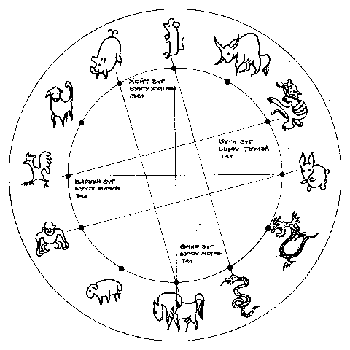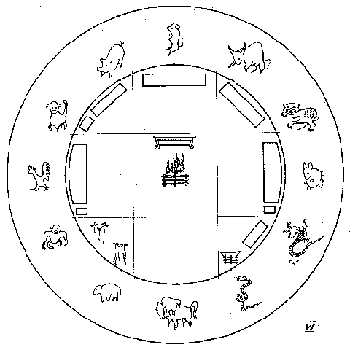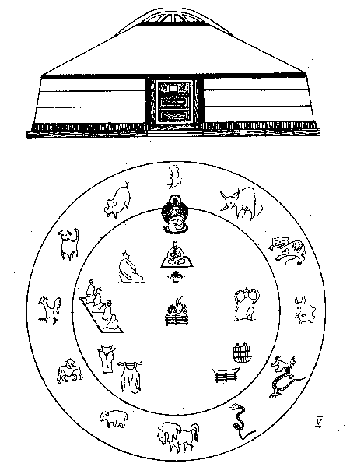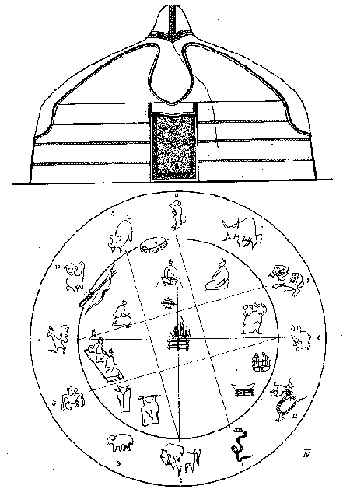

Before the 17th century, Mongolians used to build their gers facing southeast. The west side of the ger was for male members of the family, the east side is for women and the honorable guests sat facing the door. When guests arrive they would sit behind the fire place, male member of the host family would sit on the northwestern part of the ger and females would sit on the left side. The altar used to be placed on the northwestern part of the ger before the Buddhism's influence. Since 17th century with buddhist introduction the custom has changed a little bit. The door faces south now and guests would take up spaces from north to west and the head of the household would sit in the north eastern part and female members of the family would sit below him.
There are twelve animals in the asian zodiak. The first animal is Rat and it represents the north in the ger. Rat is a symbol of wealth and wisdom.
On the right, or west, side of the ger there would be the youngest kid and lamb from the heard, saddle, hobble, briddle, kumis bag, men and children's clothing storage, man's bed, men's valuable posessions in the chest and his weapons hung on the wall. The reason of kumis bag is being on the man's side is that in old days men used to milk mares and make kumis.
On the back of the ger, north or north western part, there is an offerring table with chests on both sides. Those chests would contain new clothes, fabrics and expensive stuff. The bed has drawers on its both sides: the top or the headboard is for hats and the footboard is for woman's dowery on the east side bed. Kitchen stuff is in southeastern part of the ger and containers with water, box for dry dungs and wood for fire and extra hearth is on the southwestern side.


Astronomy was one of the well developed sciences in Mongolia. In fact in 1428 Ulugbeg (1394-1449), son of Taragai, grandson of Tomor of Barlas clan built an observation station in Samarkand. This fascination with stars and planets reflects in the structure of the Mongolian gers. The basic 4 khana ger has 14 heads (poles on each khana) and 4 poles' heads on the door. This coinsides with modern clock structure. The space between poles is more or less 6 degrees. The pole space on khanas represents 60 years: the right most pole space on the door is blue male horse year, the north most pole space is blue male rat year, the very first pole space on khana on the south west is blue female ship year, the 14th (last space for the first khana) space is yellow male monkey, and the second khana starts with red female rooster year and ends with black male dog year, the third khana starts with black female pig year, and ends with red male rat year, 4th khana starts with red female ox year and ends with white male tiger year. The morning starts at rabbit time (6 a.m.), then dragon time (8 a.m.), snake (10 a.m.), horse (12 p.m.), sheep (2 p.m.), monkey (4 p.m.) and rooster (6 p.m.). Since Mongolians used to face the door to southeast it is 6-12 degrees tilted from the pole so the first sunlight showes around 6:48 a.m. This relates to having 4 seasons in that region.


The fire place, the hearth of the ger, is very important for Mongolians. It is considered as the root of that family and it is called Ghal Gholomt. The youngest boy of the family inherits the family Ghal Golomt. Chinggis Khaan's youngest son Tuluy inherited all his father's wealth.
There are four ways to greet people:
First two are used if the guests are elderly, honorable or high ranking officials. If the guests are younger then the host then the last two applies. Elderly people usually give a kiss on cheeks but other than that Mongolians do not kiss or hug each other. Usual 15-20 degree bow is common.
Mongolian men do not grow their mustache until they hear their grandchildren's cry or until they are fourty. Also if their fathers are alive men are not allowed to have a mustage.
© 2006, by B. Mendsaikhan, in the SCA: Bambar Ghoa
return to the Silver Horde home page.